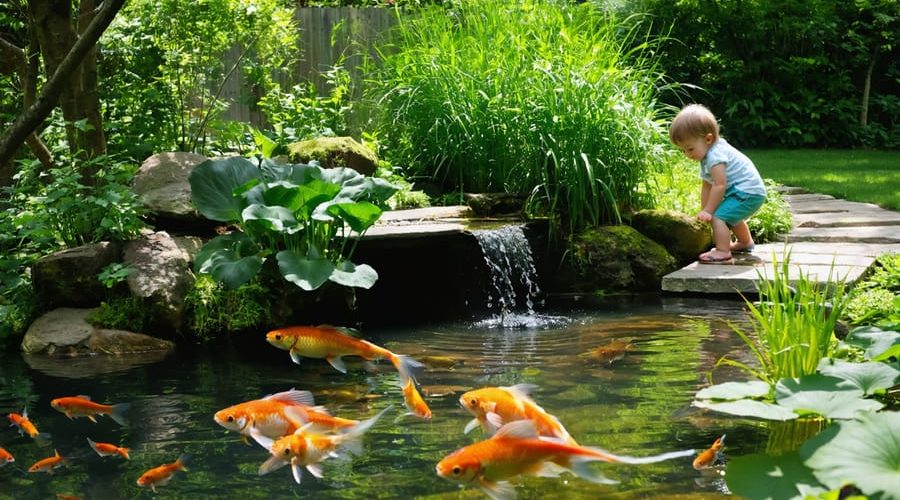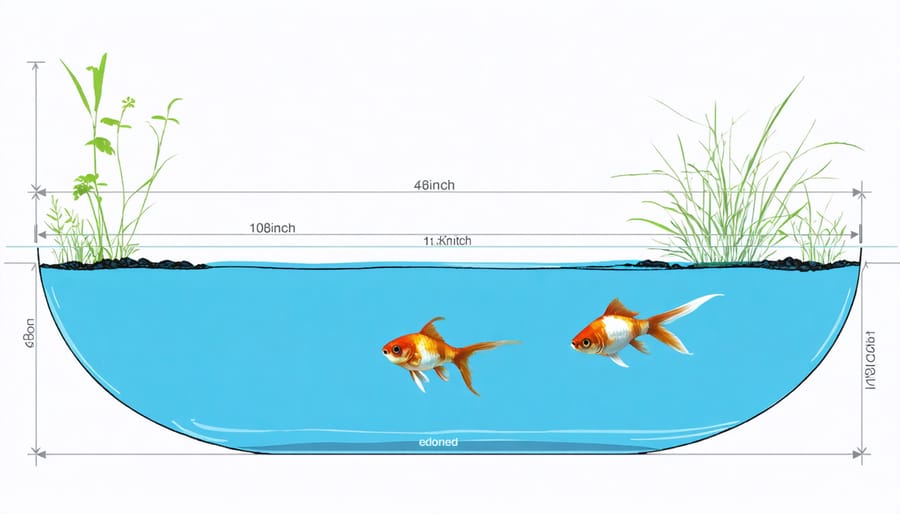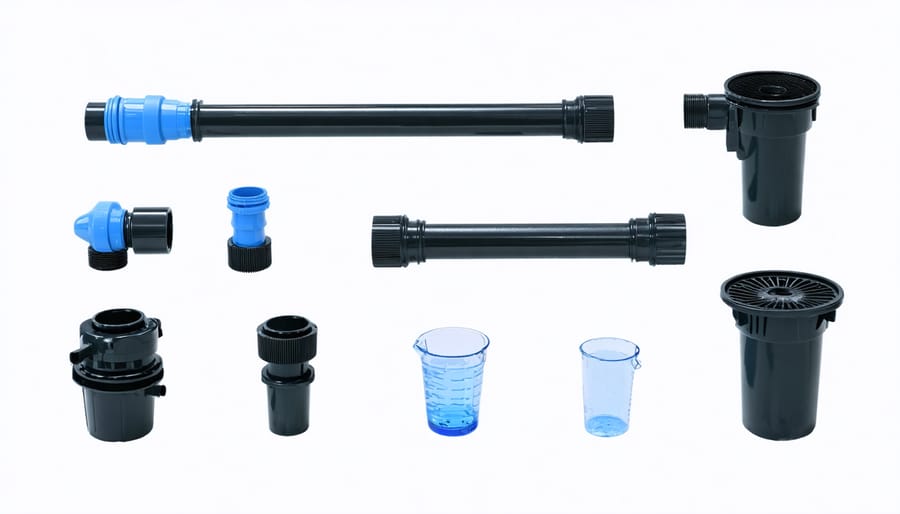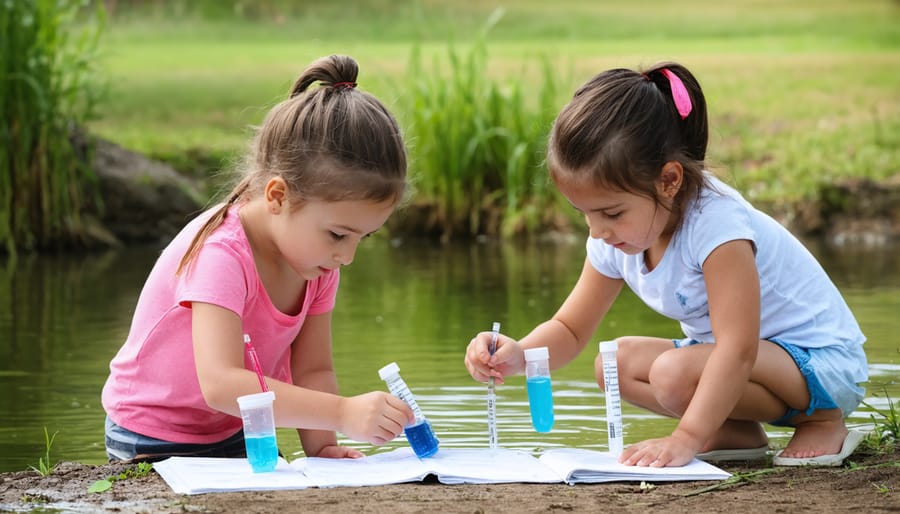
Transform Your Backyard Into a Living Classroom With a Goldfish Pond
Transform your backyard into a living classroom with a goldfish pond that brings nature’s wonders right to your doorstep. Building your first goldfish pond combines the simple joy of keeping fish with the rewarding challenge of creating a thriving ecosystem. Beyond just a water feature, a well-designed goldfish pond becomes a dynamic habitat that teaches children about biology, chemistry, and environmental stewardship through hands-on experience.
Start small with a 300-gallon pond – deep enough to protect fish during winter yet manageable for beginners. Position your pond where it receives morning sun but afternoon shade, creating optimal conditions for both fish and aquatic plants. Install a reliable filtration system and add beneficial bacteria to establish the nitrogen cycle, ensuring your goldfish thrive in crystal-clear water.
Choose hardy varieties like Common Goldfish or Shubunkins for your first pond inhabitants. These resilient fish adapt well to outdoor conditions and display fascinating natural behaviors that capture imagination and inspire learning. With proper planning and maintenance, your goldfish pond will evolve into an engaging outdoor laboratory where discovery happens daily.
Planning Your Educational Goldfish Pond
Choosing the Perfect Location
Selecting the right spot to build your pond ecosystem is crucial for both your goldfish’s health and your enjoyment. Choose a relatively flat area that receives partial sunlight – about 4-6 hours daily is ideal. Too much sun can cause algae growth, while too little might affect plant health.
Keep safety in mind by positioning the pond where you can easily supervise children. Consider installing a protective fence or grate if young children frequent your yard. Place the pond where it’s visible from your favorite outdoor sitting area or kitchen window, making it easy to monitor your fish and enjoy their activities.
Avoid locations under trees if possible, as falling leaves can create extra maintenance work and affect water quality. Also, ensure the spot has good drainage and is away from low-lying areas that might flood during heavy rain. If you’re planning to add a filter system or pump, check that electrical outlets are accessible but safely distanced from the water.
Remember, your pond should be both a beautiful feature and a practical addition to your outdoor space.
Size and Depth Requirements
For a beginner’s goldfish pond, size matters more than you might think. A good starting point is a pond that’s at least 50 square feet in surface area and 2 feet deep. This gives your goldfish enough space to swim, grow, and thrive while remaining manageable for newcomers to pond keeping.
The minimum depth of 2 feet serves multiple purposes: it helps regulate water temperature, provides fish with a safe zone during winter, and offers protection from predators. In warmer climates, you might want to go a bit deeper, around 3 feet, to keep the water cooler during summer months.
Shape-wise, aim for a design that includes both shallow and deep areas. A shallow shelf around the edges (12-18 inches deep) works great for aquatic plants, while the deeper center section gives fish their necessary swimming space. For every goldfish, plan on having about 20 gallons of water, so a pond measuring 6 feet by 8 feet would comfortably house 4-5 adult goldfish.
Remember, it’s better to start slightly larger than you think you need – goldfish grow quickly, and a bigger pond is actually easier to maintain as it creates a more stable ecosystem.

Essential Equipment and Setup
Filtration Systems
A good filtration system is the heart of any healthy goldfish pond, keeping the water clear and your fish happy. For beginners, there are three main types of filters to consider: mechanical, biological, and UV clarifiers.
Mechanical filters are your first line of defense, catching leaves, debris, and other floating particles. Think of them as giant pond strainers. A simple box filter or skimmer placed at the pond’s surface works well for most small ponds, collecting debris before it can sink to the bottom.
Biological filters use beneficial bacteria to break down fish waste and other harmful substances. These can be as straightforward as a container filled with special filter media where good bacteria can grow. Many beginners start with an all-in-one filter system that combines mechanical and biological filtration in one unit – it’s like having a mini water treatment plant for your pond!
UV clarifiers are optional but helpful additions that clear green water by eliminating single-celled algae. While not essential for beginners, they’re worth considering if you want crystal-clear water.
For a small goldfish pond (around 500 gallons), start with a filter rated for at least twice your pond’s volume. This gives you plenty of filtering power and room for error as you learn. Remember to clean your filters regularly and replace the media as recommended by the manufacturer.

Water Quality Tools
Monitoring your goldfish pond’s water quality doesn’t need to be complicated or expensive. Start with a basic water testing kit that measures essential parameters like pH, ammonia, nitrites, and nitrates. These kits usually come with color-coded charts and simple instructions, making them perfect for beginners and young learners.
A digital thermometer is another must-have tool for maintaining healthy pond water. Look for one with a waterproof probe that can give you quick readings. Keep a simple logbook to track your measurements – this creates an excellent opportunity for recording data and observing patterns over time.
Consider investing in a water clarity disc (also called a Secchi disk). This simple tool helps you measure water transparency and can be a fun way to involve kids in pond maintenance. You can even make your own using a white plastic lid attached to a measuring stick!
Don’t forget about basic observation tools like a magnifying glass and a small net for collecting water samples. These tools allow you to examine microscopic pond life and learn about your pond’s ecosystem up close. A pH pen can also be helpful for quick daily checks, though it’s not essential when you’re just starting out.
Remember to store all your testing supplies in a dedicated container away from direct sunlight and extreme temperatures to ensure accurate readings.
Creating Educational Opportunities
Water Quality Monitoring
Monitoring your pond’s water quality doesn’t require a chemistry degree! With some simple tools and observations, you can keep your goldfish healthy and happy. Start by getting a basic water testing kit from your local pet store – these usually include tests for ammonia, nitrites, pH, and nitrates.
Test your pond water weekly, especially during the first few months. Dip the test strips into the water and compare the colors to the chart provided. Clear water doesn’t always mean healthy water, so don’t skip this step! Keep a small notebook near your pond to track your readings – this helps you spot patterns and potential problems early.
Watch for visual clues too. Healthy pond water should be clear with a slight green tint. If you notice your water turning murky, excessively green, or developing a bad smell, it’s time to investigate. You can also learn a lot from your fish’s behavior – happy goldfish are active and swim throughout the pond, while stressed fish might hide or gasp at the surface.
A simple clarity test involves placing a white object (like a dinner plate) about 18 inches deep in your pond. If you can see it clearly, your water clarity is good. If not, you might need to adjust your filtration or reduce feeding.
Remember, small changes are better than big ones when correcting water problems. Sudden adjustments can stress your fish more than slightly imperfect conditions.

Goldfish Behavior Studies
Observing your goldfish’s behavior can be both fascinating and rewarding, helping you better understand their needs and ensure their wellbeing. Start by creating a simple observation journal where you can record daily activities like feeding patterns, swimming depths, and social interactions between fish.
Morning and evening observations are particularly revealing, as these are typically the most active times for goldfish. Watch how they interact with plants, explore their environment, and respond to changes in lighting. Note any unusual behaviors like rubbing against surfaces, staying at the bottom, or swimming erratically, as these could indicate health issues.
Try conducting simple experiments to learn more about your fish’s preferences. Place food in different locations to observe their foraging patterns, or introduce new objects to see how they react to changes in their environment. Pay attention to their color changes throughout the day and during different weather conditions.
Children especially enjoy participating in behavior studies. Create a checklist of behaviors to watch for, such as bubble blowing, surface feeding, or playing in water features. Use a timer to track how long your fish spend in different areas of the pond, and note which spots seem to be their favorites.
Remember to observe your fish before and after maintenance activities to understand how they respond to changes in their environment. This knowledge will help you create a more comfortable habitat for your aquatic friends while building a deeper connection with them.
Ecosystem Interactions
A goldfish pond is more than just a water feature – it’s a thriving miniature ecosystem where every element plays a crucial role. Understanding these aquatic ecosystem interactions will help you create a balanced and healthy environment for your fish.
Plants are the foundation of your pond’s ecosystem. Floating plants like water lilies provide shade and shelter for your goldfish, while submerged plants like hornwort help oxygenate the water. These plants also compete with algae for nutrients, naturally keeping green water at bay.
Your goldfish contribute to this cycle by producing waste that fertilizes the plants. They also help control insect populations by feeding on mosquito larvae and other small aquatic insects. In return, beneficial insects like dragonflies and water striders help keep pest populations in check and add fascinating life to your pond.
The relationship between these elements creates a natural filtration system. Plants absorb fish waste, insects feed on decaying matter, and bacteria break down organic materials. When these relationships are in balance, your pond becomes largely self-sustaining, requiring less maintenance from you.
Watch how your goldfish interact with different plants and observe which areas of the pond they prefer. These observations will help you make better decisions about plant placement and pond design, creating an environment where all inhabitants can thrive together.
Maintenance as a Learning Tool
Seasonal Care Activities
Taking care of your goldfish pond changes with the seasons, creating perfect opportunities to learn about nature’s cycles. In spring, you’ll start by clearing out debris that accumulated over winter and checking your pump and filter systems. This is a great time to observe how aquatic plants begin to sprout and watch your goldfish become more active as the water warms up.
Summer maintenance involves regular water testing and managing algae growth. Keep an eye on water levels, as warm weather increases evaporation. It’s fascinating to watch how your fish behave during feeding time and how they interact with different plants. Remember to trim back any overgrown vegetation that might shade your pond too much.
Fall brings falling leaves, making it the perfect time to learn about decomposition and its effects on water quality. Install a pond net to catch leaves before they sink. Watch how your fish’s activity levels change as temperatures drop, and they prepare for winter.
Winter care focuses on keeping a small area free from ice for gas exchange. If you live in a cold climate, you’ll learn about how goldfish adapt to lower temperatures by slowing down their metabolism. This is also an excellent time to plan next year’s improvements and reflect on what you’ve learned throughout the seasons.
Remember to keep a pond journal to track seasonal changes, maintenance tasks, and interesting observations. This creates a valuable record of your pond’s yearly cycle and helps you better understand its ecosystem.
Problem-Solving Exercises
Let’s tackle some common pond problems you might encounter and turn them into valuable learning experiences. When your water turns green, it’s usually an algae bloom caused by excess nutrients. Try reducing fish feeding and adding more aquatic plants – this teaches the importance of natural balance in ecosystems. If you notice your goldfish gasping at the surface, check your pump and aeration system, as this demonstrates how oxygen levels affect aquatic life.
Dealing with falling leaves? Create a maintenance schedule with your family to net them out regularly. This helps everyone understand decomposition and its effects on water quality. When predators like herons visit your pond, use it as an opportunity to discuss food chains and install protective measures like floating decoys or netting.
If your water level drops mysteriously, look for leaks but also discuss the water cycle and evaporation rates in different weather conditions. Notice your fish hiding more than usual? This could indicate stress from water quality issues or predator presence – a perfect chance to learn about fish behavior and instincts.
Remember, every challenge is an opportunity to understand pond ecosystems better. Keep a pond diary to track problems and solutions, helping you spot patterns and prevent future issues. This way, you’re not just maintaining a pond; you’re building expertise through hands-on experience.
Creating a goldfish pond is more than just a backyard project – it’s an exciting journey into the world of aquatic ecosystems. Not only will you enjoy the serene beauty of your pond, but you’ll also gain hands-on experience in water management, fish care, and natural biology. Whether you’re a parent looking to teach your children about nature or simply someone eager to create their own peaceful water garden, a goldfish pond offers endless opportunities for learning and enjoyment. Start small, follow the guidelines we’ve discussed, and don’t be afraid to make adjustments as you learn. Remember, every successful pond keeper started as a beginner, and with patience and dedication, you’ll soon be watching your own golden beauties glide through crystal-clear waters. Why not begin your pond adventure today?
